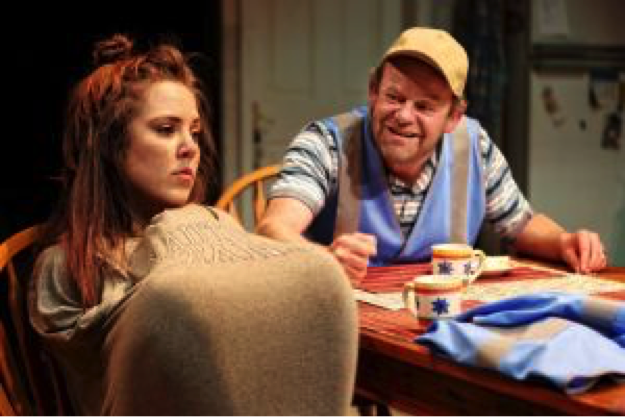By Tom Wells. Ensemble Theatre, Sydney. Director: Shane Bosher. 14 October – 18 November 2017

“A nice little play” someone said as we left the theatre – and it is! It’s gentle, funny and very natural, from the characters themselves to the set on which they engage. Both are crowded with all the recognisable material and emotional baggage of family life.
The action takes place in the kitchen-dining room of a family home in Yorkshire. Designed by Charles Davis, the set is the typical ‘ordered disorder’ of a busy household. Cupboards, counter tops, windowsill and cooker are jam-packed with the trappings of daily living. A claw hammer lying beside the sink is a good indication that there is a problem with the plumbing!
A large oil painting of a woman leaning against the bench seems a little out of place until we meet teenage son, Billy. The painting is of Dolly Parton and it’s part of the portfolio he will submit as his application to art school. He’s a in a bit of dilemma about the nipples – and whether to add sequins. It’s not really something about which his mother, Kath, a school dinner lady, or his father, Martin, a milkman, can advise him – nor something that interests his aspiring black-belt martial arts sister, Sophie or her very reticent boyfriend, Pete.
Tom Wells has created characters that are immediately recognisable and credible. They speak to each other naturally, often in phrases or unfinished sentences. They know what they are inferring – and in the hands of this cast, and director Shane Bosher, so does the audience. Dialect coach Amy Hume has ensured the veracity of the Yorkshire accents. Bosher has ensured the actors have become the family that Wells, and he, envisaged. The action – and the choreography between scenes – is unaffectedly ‘normal’. The relationships are convincing. The dialogue is punctuated with the typical pace, pauses and reactions of familiar conversations, even when things go wrong … as, with all families, they do.

Hannah Waterman and Huw Higginson bring their wealth of experience to the characters of Kath and Martin. Waterman’s Kath is always busy, always thinking ahead, understanding but just a little preoccupied with the future – namely the diminishing number of customers on Martin’s milk run. Martin is in denial, using an optimistic front to cover the truth. Higginson finds all of this in a performance that inspires genuine sympathy and understanding. Together they are a convincing, married couple, arguing over their children, niggling at each other one moment, supporting each the next.
Ben Hall is loveable as the gentle Billy, unsure of his ability or how he’ll cope with the art school in London. Lean and lanky, Hall makes him a bit hesitant, a bit tentative, a bit uncertain about his feelings – but very supportive of his family.
Sophie, on the other hand, is very confident and self-assured – until she punches her martial arts assessor for constantly referring to her as ‘feisty’. Her career aspirations broken, she reverts to sullenness, and Contessa Treffone makes that change very effectively. She shows the loss of self-esteem in monosyllabic reactions and a totally different persona that almost seems to shrink inside itself. Her facial expressions as she listens and watches, articulate her thoughts as surely as any dialogue might have done.
Duncan Ragg plays her boyfriend Pete, a plumber who is saving to buy a van to replace his bicycle. (When he does, it’s a bright pink, which doesn’t impress Sophie at all!). Ragg is even more hesitant than Pete. He never actually finishes a sentence … or a thought … and Ragg makes him completely believable and endearing, from the concern he shows for his aging Gran, to his attempt to repair the plumbing, to his rolling a marijuana cigarette for Kath.
Together they are tightly knit unit of performers who make the problems that overwhelm these characters engagingly realistic. They argue and console, criticise and support, laugh and cry in a series of events that are, because of the Bosher’s detailed attention to characterisation, pace and control, both entertaining and moving.